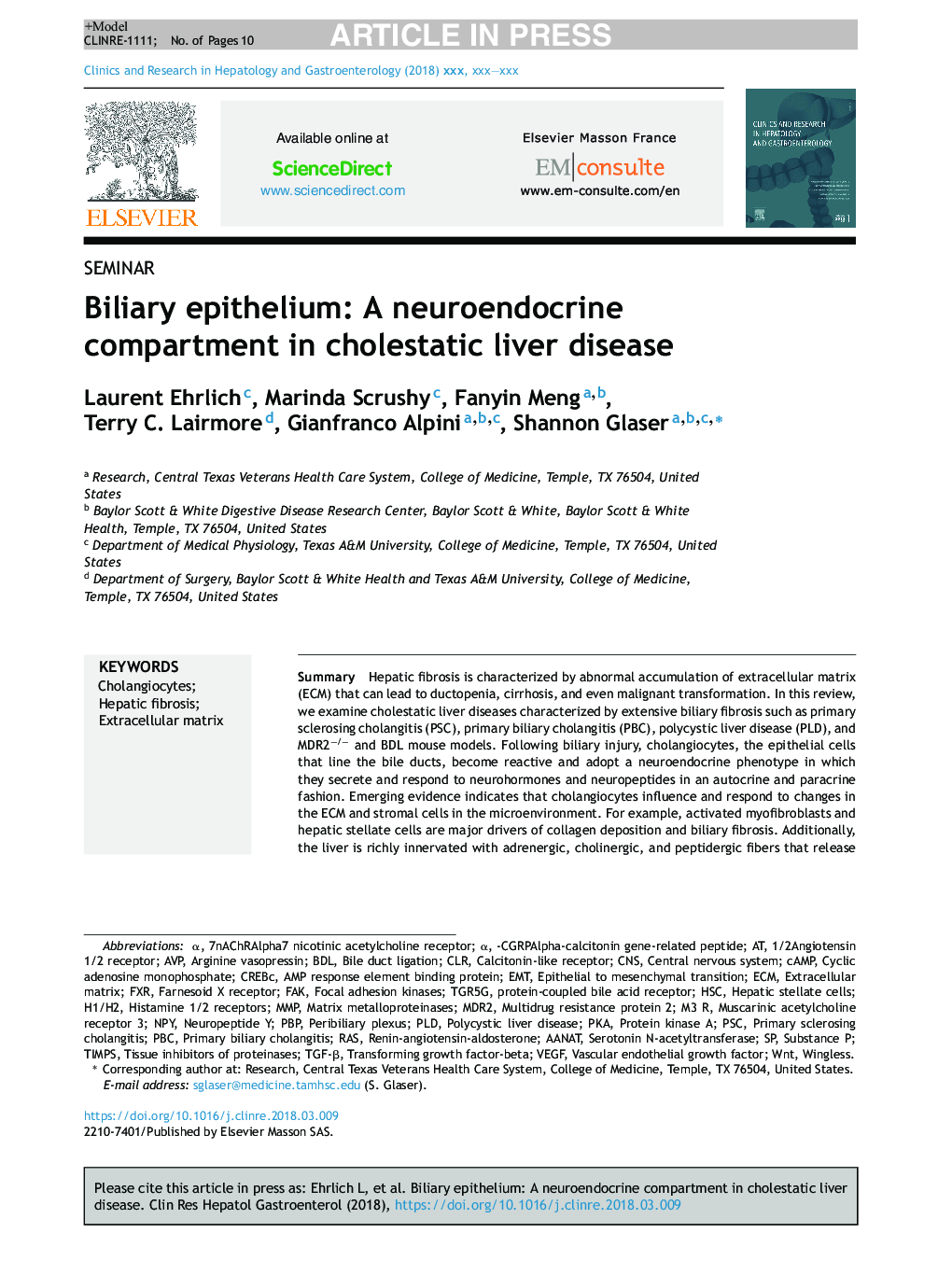| کد مقاله | کد نشریه | سال انتشار | مقاله انگلیسی | نسخه تمام متن |
|---|---|---|---|---|
| 8963974 | 1646636 | 2018 | 10 صفحه PDF | دانلود رایگان |
عنوان انگلیسی مقاله ISI
Biliary epithelium: A neuroendocrine compartment in cholestatic liver disease
ترجمه فارسی عنوان
اپیتلیوم صفراوی: محفظه عصبی عضلانی در بیماری کبد کلستاتیک است
دانلود مقاله + سفارش ترجمه
دانلود مقاله ISI انگلیسی
رایگان برای ایرانیان
کلمات کلیدی
RASFXRPBCCLRWntCholangiocytesAVPpKaBDLNPYPSCFAKECMHSCPBPMdr2PLDTGF-βTIMPsMMPcAMP - cAMPprimary biliary cholangitis - Cholangitis اولیه صفراویfarnesoid X receptor - Farnesoid X گیرندهCyclic adenosine monophosphate - آدنوزین مونوفسفات Cyclicepithelial to mesenchymal transition - اپیتلیال به انتقال مزانشیمالWingless - بی نهایتpolycystic liver disease - بیماری کبدی پلی کیستیکtransforming growth factor-beta - تبدیل فاکتور رشد بتاEMT - تکنسین فوریتهای پزشکیCNS - دستگاه عصبی مرکزیrenin-angiotensin-aldosterone - رنین-آنژیوتانسین-آلدوسترونSerotonin N-acetyltransferase - سروتونین N-استیل ترانسفرازHepatic stellate cells - سلولهای ستارهای کبدیcentral nervous system - سیستم عصبی مرکزیAANAT - عنانVascular endothelial growth factor - فاکتور رشد اندوتلیال عروقیVascular Endothelial Growth Factor (VEGF) - فاکتور رشد اندوتلیال عروقی (VEGF)Hepatic fibrosis - فیبروز کبدیExtracellular matrix - ماتریکس خارج سلولیSubstance P - ماده PMatrix metalloproteinases - متالوپروتئیناز ماتریکسarginine vasopressin - وازوپرسین آرژینینMultidrug resistance protein 2 - پروتئین مقاومتی چند دارویی 2protein kinase A - پروتئین کیناز Abile duct ligation - پیوند مجرای صفراویPrimary sclerosing cholangitis - کلانژیت اسکلروئیدی اولیهCalcitonin-like receptor - گیرنده کلسیتونین مانندNeuropeptide Y - یوروپروتئین Y
موضوعات مرتبط
علوم پزشکی و سلامت
پزشکی و دندانپزشکی
بیماریهای گوارشی
چکیده انگلیسی
Hepatic fibrosis is characterized by abnormal accumulation of extracellular matrix (ECM) that can lead to ductopenia, cirrhosis, and even malignant transformation. In this review, we examine cholestatic liver diseases characterized by extensive biliary fibrosis such as primary sclerosing cholangitis (PSC), primary biliary cholangitis (PBC), polycystic liver disease (PLD), and MDR2â/â and BDL mouse models. Following biliary injury, cholangiocytes, the epithelial cells that line the bile ducts, become reactive and adopt a neuroendocrine phenotype in which they secrete and respond to neurohormones and neuropeptides in an autocrine and paracrine fashion. Emerging evidence indicates that cholangiocytes influence and respond to changes in the ECM and stromal cells in the microenvironment. For example, activated myofibroblasts and hepatic stellate cells are major drivers of collagen deposition and biliary fibrosis. Additionally, the liver is richly innervated with adrenergic, cholinergic, and peptidergic fibers that release neurohormones and peptides to maintain homeostasis and can be deranged in disease states. This review summarizes how cholangiocytes interact with their surrounding environment, with particular focus on how autonomic and sensory regulation affects fibrotic pathophysiology.
ناشر
Database: Elsevier - ScienceDirect (ساینس دایرکت)
Journal: Clinics and Research in Hepatology and Gastroenterology - Volume 42, Issue 4, September 2018, Pages 296-305
Journal: Clinics and Research in Hepatology and Gastroenterology - Volume 42, Issue 4, September 2018, Pages 296-305
نویسندگان
Laurent Ehrlich, Marinda Scrushy, Fanyin Meng, Terry C. Lairmore, Gianfranco Alpini, Shannon Glaser,
